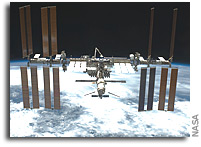NASA ISS Expedition Lead Scientist: Highlights: Week of March 24, 2014

Aboard the International Space Station, Japan Aerospace Exploration Agency (JAXA) astronaut Koichi Wakata installed the canisters that arrived on the Soyuz spacecraft into the Protein Crystallization Research Facility for the JAXA Protein Crystal Growth (PCG) study. The main scientific objective of the investigation is to make fine quality protein crystals in space, and it will show how effective the space station is for investigations of this type. This experiment contributes to society by helping to design new drugs to fight diseases, and new catalysts for the environmental and energy industries.
NASA astronaut Steven Swanson set up blood and saliva collections for theSalivary Markers study. The investigation involves the collection of blood, saliva, urine and a health assessment on six subjects pre-, in- and post-flight to determine if spaceflight-induced immune system dysregulation increases infection susceptibility or poses a health risk to crews aboard the space station. The data collected during this study may lead to an understanding of how the immune system is affected by different factors from stress to the environment. The information could be used to help develop new treatments and preventative measures for immune dysfunctions.
The crew installed the 17 dosimeters — a device for measuring doses of radiation — that arrived on the Soyuz for the Area Passive Dosimeter for Life-Science Experiments in Space (Area PADLES) study. This investigation uses dosimeters to continuously monitor the radiation dose aboard the space station. Radiation exposure can have significant biological effects on living organisms, and on the biological investigations being done on the station and on the Japanese Experiment Module, known as Kibo. By installing dosimeters at 17 fixed locations inside the Kibo, continuous area radiation monitoring can be provided. The dosimetry technique is already used for dose management of radiation workers in high-energy accelelators. The high-speed microscope scanning image techniques are used in the diagnosis of cancer cells.
Wakata installed the passive dosimeters that arrived on the Soyuz for the DOSIS-3D study. DOSIS-3D is short for Dose Distribution Inside the International Space Station-D. DOSIS-3D measures radiation field parameters such as absorbed dose and dose equivalent at different locations inside the space station, using active and passive radiation detector devices. The aim is to produce a three-dimensional dose distribution map of all segments of the station. This study further enlightens scientists of the use of devices for data collection and how to monitor real-time data. This could prove beneficial to radiation monitoring of commercial airline crews and military flight crews.
Operations were completed for the Superconducting Submillimeter-Wave Limb-Emission Sounder (SMILES) study. It was deactivated and will be disposed of on H-II Transfer Vehicle (HTV)-5. The main scientific objective of the SMILES mission is to study the recovery and stability of the stratospheric ozone, also known as the ozone layer. SMILES is the first aboard mechanically cooled superconducting mixer and high-resolution system for measuring atmospheric minor constituents related to stratospheric and mesospheric chemistry. It was launched on HTV-1 in 2009 and operated for over four years.
Other human research investigations continued for various crew members including Journals, Reaction Self Test, Space Headaches and Space Linear Acceleration Mass Measurement Device (SLAMMD).








